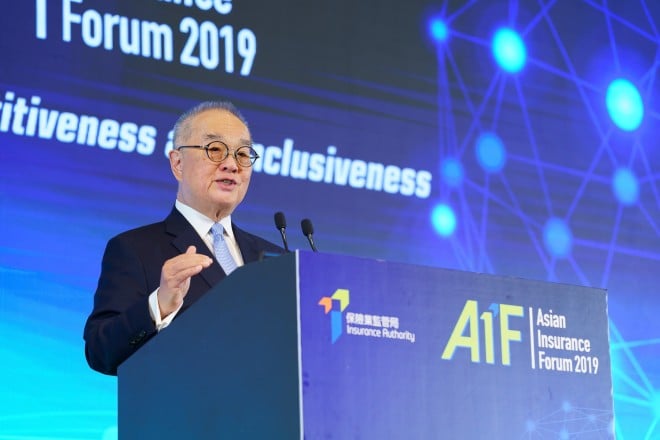
Experts discuss how insurtech, GBA bring insurers new opportunities at industry forum
[Sponsored Article]
There are lots of opportunities for insurers to grow their business by embracing insurtech and extending coverage to the Greater Bay Area (GBA), according to leading industry players, experts and regulators at the Asian Insurance Forum hosted by the Insurance Authority (IA) on December 10.
In her opening keynote address, Carrie Lam, Hong Kong's Chief Executive and the forum’s officiating guest, said GBA development and the Belt and Road Initiative present a huge potential to the insurance sector. Since announcement of the Outline Development Plan for the Guangdong-Hong Kong-Macao Greater Bay Area (ODP) in February and the third plenary meeting of the Leading Group for the Development of GBA in November, 16 new policy measures to strength Hong Kong’s status as a global risk management centre have been formulated.

“Among other things, Hong Kong can become the risk management centre for state-owned enterprises investing in major Belt and Road projects and looking to expand their market presence,” she added.
She also noted that fintech is rapidly changing the landscape of the insurance industry; and assured Hong Kong is on its way to realising the vast opportunities presented by fintech.
“As a regulator, we do see insurtech as a positive disruption to the market and we have a role to foster its adoption to enhance policyholder protection, and to bring insurance to under-served segments of the population,” said Dr Moses Cheng, Chairman of the IA in his opening address.

As part of the government-led drive to foster fintech development, the IA has so far issued virtual insurer licenses under the Fast Track scheme to one life insurer and one general insurer, both of which are now operational. The Insurtech Sandbox provides a controlled environment for insurers to test innovative solutions using real market data, he said, adding that four out of the six approved applications had been rolled out.
Regulators urged to keep up with pace of innovation
No doubt fintech, including insurtech, brings huge potential to the betterment of social welfare, but the regulatory structure also needs to adapt to new changes in order to overcome barriers and close the protection gap, said Johnathan Dixon, Secretary General of the International Association of Insurance Supervisors. As the industry continues to undergo a digital transformation, regulators have to digitalise the compliance and enforcement process to keep up with the pace, he said.
His view was echoed by Professor Douglas Arner, the Kerry Holdings Professor in Law at the University of Hong Kong. “Regulators need to do two things. First, understand the market dynamics and trends in technology convergence. Second, think about—and be prepared for—what if things go wrong.”
Henri Arslanian, the PwC fintech and crypto leader for Asia and Chairman of the FinTech Association of Hong Kong, sees the granting of virtual bank and insurer licences as a major leap forward in driving innovation in a traditional business model. “For insurance companies, the management’s top-down commitment to driving change is very important. Regulators are also expected to keep up with disruptive innovation. All have a role to play.”
More co-operation expected to facilitate innovations
Raymond Tam, Executive Director (Policy and Development) at the IA, said that the IA is committed to facilitating the industry with the use of technology to close the protection gap. The insurance sector has to take advantage of technological advancements while it may take time for laws and regulations to keep pace.
“We’re still in the early development of insurtech… digital insurers must move boldly and proactively and engage customers in new ways in order to stay competitive. The arrival of 5G and IoT technologies will help create greater levels of granularity in risk models and shift insurers closer to personalisation,” said Tam.

Stephen Po, Executive Director (Market Conduct) at the IA, reassured that regulators and insurers must and will work together to ensure consumers benefit from digital innovation.
“There are a lot of possibilities regulators and industry players can explore together to streamline the compliance process. How about setting up a system for regulators to access real-time financial data of insurers so that they do not have to file the documents manually every time?” said Po. “In the digital age, international co-operation and co-ordination among financial regulators is critically important to effectively achieving their mission.”
Apart from working with insurers, regulators are working closely with policymakers to promote policies that encourage both innovation and effective competition among industry players, and that also support the protection of consumers, said Alan Au, Executive Director (Banking Conduct) at the HKMA.
“What technology aims to do just comes down to three words: customer, customer and customer. That translates into customer experience, customer protection, and customer outcome,” said Au.
Embrace technology to revamp industry
Traditional insurers are recognising the critical moment that they ought to digitalise or they will be left behind. Consumer demand is the major catalyst for digital transformation: People want interactions with insurers to be as easy, convenient and transparent as tapping on their smartphone.
Mark Saunders, Group Chief Strategy & Corporate Development Officer of the AIA Group Limited, said, “We develop and invest in insurtech solutions across three horizons. First, we invest to automate and digitise all back-office processors in order to accelerate the submission, underwriting, claims, policy servicing and other aspects of the business that the customer needs. The second horizon is where we help our agents interact better with our customers. And the third horizon is to transform the way we do business.”
Recognised as an early insurtech adopter, Ping An Insurance, the world's largest insurer, leverages data-driven business models to stay ahead of the game, said Jonathan Larsen, Chief Innovation Officer of the group and Chairman and CEO of the Ping An Global Voyager Fund. The company has also obtained a virtual bank licence in Hong Kong.
With about 1.3 million insurance agents across the country, Ping An has expanded its reach to offer healthcare consultations, auto sales, real estate listings and banking services to more than 350 million online customers through a single customer portal called the One Account. This new activity also generates customer traffic for Ping An’s core services, he said.
Seeking to democratise the industry, Bowtie, a virtual insurer based in Hong Kong, offers commission-free life, health and medical insurance plans through its online platform. The company leverages new technology to reach out to customer segments that could not be reached through traditional channels. “Technology-based solutions can therefore be employed to help bridge the gap between insurers and those previously under-protected, like millennials who rely a lot on their smartphone and the underprivileged who are more sensitive to costs,” said John Tsang, Senior Advisor of Bowtie, better known for his former role as Hong Kong’s Financial Secretary.
HK insurers set to benefit from Greater Bay Area blueprint
Hong Kong and the other GBA cities are likely to see an increase in cross-border insurance and banking activity under the blueprint unveiled by the Central People’s Government in February.
The ODP formally lays out the blueprint for GBA. The closer ties between the three places are of great significance to the strengthening of market infrastructure and interoperability, as well as financial system optimisation, said Liu Fushou, Chief Counsel of the China Banking and Insurance Regulatory Commission.
“Policymakers and regulators will work together on many fronts to reduce entry barriers for Hong Kong-based insurers to operate their business in GBA and solidify Hong Kong’s position as a global risk management centre and a regional insurance hub,” he said.
Several panellists, including Mike Wells, Group Chief Executive of Prudential plc and Clarence Wong, Chief Economist Asia of Swiss Re, said the industry is eagerly looking forward to launching of the GBA Wealth Management Connect scheme, first proposed in 2018, that would allow cross-border sale of wealth management products between the Mainland and Hong Kong, and might present a conduit for similar flow of insurance products in future.
Based on the experience of the stock and bond connect schemes, Mao Zhirong, Managing Director and Head of Mainland Development of the Hong Kong Exchanges and Clearing Limited, said mutual respect and co-operation, policy and regulatory support and sustainable investor demand are key to the success of cross-border channels.

In his closing remarks, Mr Clement Cheung, Chief Executive Officer of the IA, concluded that the forum provided opportunity for regulators and industry practitioners to share their views from different perspectives. “We were pleasantly surprised when almost full capacity was snapped up just a few weeks after the invitations were issued,” said Cheung. The forum this year brought together around 500 distinguished delegates from local and overseas as well as senior representatives from all the four financial regulators in Hong Kong.
